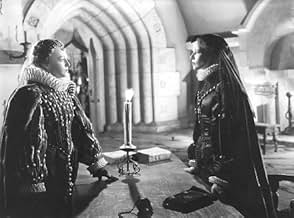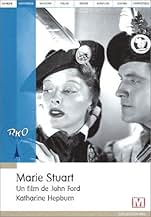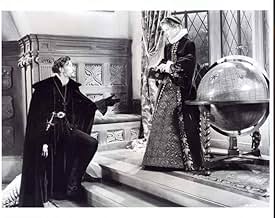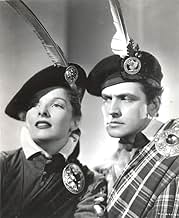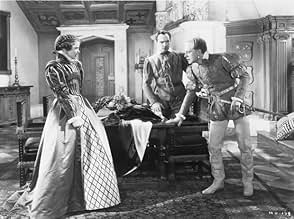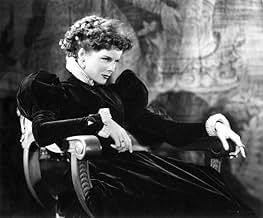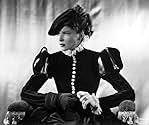AVALIAÇÃO DA IMDb
6,3/10
2,9 mil
SUA AVALIAÇÃO
Adicionar um enredo no seu idiomaThe recently widowed Mary Stuart returns to Scotland to reclaim her throne but is opposed by her half-brother and her own Scottish lords.The recently widowed Mary Stuart returns to Scotland to reclaim her throne but is opposed by her half-brother and her own Scottish lords.The recently widowed Mary Stuart returns to Scotland to reclaim her throne but is opposed by her half-brother and her own Scottish lords.
- Direção
- Roteiristas
- Artistas
- Prêmios
- 3 vitórias e 1 indicação no total
- Direção
- Roteiristas
- Elenco e equipe completos
- Produção, bilheteria e muito mais no IMDbPro
Avaliações em destaque
This is a good costume-designing , historic-drama and Katherine Hepburn is well cast in the title role . She plays a tragic , romantic heroine that contends with various treacheries . Mary (1516-1558) inherited the throne of Scotland from Jacob V . She was next in line to the English kingdom , and married Francisco II , king of France , but he died early . Having been in France for thirteen years , Mary returned Scotland , and arrives from France with some misgivings . Then , Mary disembarks in Leith and goes to a castle near Edimburg , along with David Rizzio (a cadaverous John Carradine) , court musician and confidant . There , she's received by his brother , the Earl James Stuart , (Ian Keith) . Later on , Queen Mary married a foppish named Lord Darnley (Walton) . But Mary falls in love with Bothwell (a stylish Fredric March) , a kilted Earl and her supporter in her battle for power . Then , Rizzio was reputed to be the father of Mary's , the future James I of England . Darnley , with some underlings , murdered Rizzio in Mary's presence . But Darnley is killed by an explosion in his refuge , outskirts Edimburg , and the God-fearing Calvinists led by John Knox (Moroni Olsen who played same role in stage) accused to Bothwell as regicide . John Knox and the rebels Lords besiege Holyrood and the Borthwell's stronghold , Dumbar castle . The Calvinists forced her abdication , Mary escapes and asks for protection to Queen Elizabeth I (Florence Eldridge) , but Mary is double-crossed and is taken imprisoned in the Tower of London . Although supposedly Mary and Elizabeth never met face to face , the movie have them doing so and the screen crackle when both have their reunion , because they are strong rivals for power in Tudor dynasty , England . After that , Mary confronts her English accusers at court in a stylized trial . Finally , the film reflects splendidly when Mary goes to beheading block with all due pomp and circumstance .
The motion picture is finely performed by Katharine Hepburn, in spite of this she was in her ¨box-office poison¨ days , the last scenes , where Mary confronts trial is so well played and photographed in a stylized manner -with Mary on the floor and judges in a sort of balcony- by cameraman Joseph August . However , the picture is interminable and overlong and some moments is frankly boring . Writing credits with excessive speeches by Maxwell Anderson (his own playwright) and Dudley Nichols , a Ford's habitual screenwriter . The picture is lavishly produced by Pandro S. Berman , an usual costumer's producer and professionally directed by John Ford . Followed by a remake with the same title (1971) with Vanessa Redgrave as Mary and Glenda Jackson as Elizabeth and directed by Charles Jarrott .
The motion picture is finely performed by Katharine Hepburn, in spite of this she was in her ¨box-office poison¨ days , the last scenes , where Mary confronts trial is so well played and photographed in a stylized manner -with Mary on the floor and judges in a sort of balcony- by cameraman Joseph August . However , the picture is interminable and overlong and some moments is frankly boring . Writing credits with excessive speeches by Maxwell Anderson (his own playwright) and Dudley Nichols , a Ford's habitual screenwriter . The picture is lavishly produced by Pandro S. Berman , an usual costumer's producer and professionally directed by John Ford . Followed by a remake with the same title (1971) with Vanessa Redgrave as Mary and Glenda Jackson as Elizabeth and directed by Charles Jarrott .
There was something of a fad for Tudor-period dramas in the late 1930s, although Mary of Scotland is something of an overlooked picture in the careers of Katherine Hepburn and John Ford. The star and director went on to have an on-off love affair, although this was the only occasion on which they worked together.
Mary of Scotland has the look that is typical of Ford's RKO features. It's often forgotten that Ford was a director who liked to work with space, shape and light, usually manifested in a sharp contrast between the indoor and outdoor worlds. Here the contrast is between the palace of Elizabeth – light, open and filled of straight lines and symmetry – and the castle of Mary – small, shadowy and made of rough curves. At first glance this seems to imply that the Scottish setting is grimmer and more confined, but for Ford these cosy spaces with layers of shadows were also about honesty and simplicity – see for example the compositions he makes in The Informer or The Fugitive. Those two pictures were also made at RKO, and their expressive look is testament to the fact that although the studio might not have had much money it did have a strong and open-minded production design team, something Ford took advantage of when he could.
By this point, few Ford films would be complete without the sing-song scene, and there is an especially fine example in Mary of Scotland. Ford never made an out-and-out musical in his career, but the way he uses singing as an emotional backdrop is remarkable. Here, the song sung by the peasants as they march into the castle begins as a simple yet effective expository device – demonstrating where the people's loyalties lie – but then the scene moves onto another level. Ford isolates one singer, then cuts to a rare close-up of Hepburn. The beauty of the music provides a backdrop to her emoting. It is in such moments that Ford's direction is at its strongest.
This was perhaps an important breakthrough role for Hepburn, whose parts until now had mostly been as teenagers or young women. This is her first real adult role and she handles it well, albeit with one or two touches of uncertainty when she is required to act "queenly". She does however manage the task of humanising the queen, more so than the screenplay would seem to allow. Unfortunately her leading man, the normally excellent Fredric March, is rather bland here. It's a real treat though to see John Carradine in a role where he really gets to show his more sensitive side. Because of his looks, not to mention his creepy voice, the character actor generally landed villainous roles, but he was actually at his best playing good guys.
One oft-repeated story regarding this production – although it varies a little depending on who's telling it, so pinches of salt at the ready – is that Hepburn and Ford disagreed over the necessity of Mary and Bothwell's final scene together on the tower top. Ford thought it a pointless bit of soppiness, Hepburn said it was the most important scene in the script. Eventually a flippant Ford challenged Hepburn to direct it herself, which she did. The scene stands out because Hepburn actually shoots it with some romantic tenderness – something Ford hardly ever did – with lengthy close-ups and rhyming angles. You can see why Ford didn't like it; he tended to downplay the love themes in his pictures, and on top of that the scene is rather heavy on dialogue. Hepburn was right though – without this scene the romance between Mary and Bothwell would be little more than a subplot, and without the romance the film wouldn't work. Audiences would find it hard to empathise with a queen clinging onto her throne, but easy to sympathise with a woman separated from the man she loves.
Mary of Scotland was not really Ford's cup of tea, and it was his rather cavalier approach to interpreting a screenplay that spoiled a fair few of his pictures (even though it won him the admiration of the auteurists). This picture is only saved by his use of music, the proficiency of the RKO crew and of course the good judgement of Katherine Hepburn. Nevertheless, I can't help but love Ford's laid-back realism. In one scene, we see a dog barking crazily at men entering a room; in another a moth flutters about John Knox's head. How many other directors of that era would have kept those takes?
Mary of Scotland has the look that is typical of Ford's RKO features. It's often forgotten that Ford was a director who liked to work with space, shape and light, usually manifested in a sharp contrast between the indoor and outdoor worlds. Here the contrast is between the palace of Elizabeth – light, open and filled of straight lines and symmetry – and the castle of Mary – small, shadowy and made of rough curves. At first glance this seems to imply that the Scottish setting is grimmer and more confined, but for Ford these cosy spaces with layers of shadows were also about honesty and simplicity – see for example the compositions he makes in The Informer or The Fugitive. Those two pictures were also made at RKO, and their expressive look is testament to the fact that although the studio might not have had much money it did have a strong and open-minded production design team, something Ford took advantage of when he could.
By this point, few Ford films would be complete without the sing-song scene, and there is an especially fine example in Mary of Scotland. Ford never made an out-and-out musical in his career, but the way he uses singing as an emotional backdrop is remarkable. Here, the song sung by the peasants as they march into the castle begins as a simple yet effective expository device – demonstrating where the people's loyalties lie – but then the scene moves onto another level. Ford isolates one singer, then cuts to a rare close-up of Hepburn. The beauty of the music provides a backdrop to her emoting. It is in such moments that Ford's direction is at its strongest.
This was perhaps an important breakthrough role for Hepburn, whose parts until now had mostly been as teenagers or young women. This is her first real adult role and she handles it well, albeit with one or two touches of uncertainty when she is required to act "queenly". She does however manage the task of humanising the queen, more so than the screenplay would seem to allow. Unfortunately her leading man, the normally excellent Fredric March, is rather bland here. It's a real treat though to see John Carradine in a role where he really gets to show his more sensitive side. Because of his looks, not to mention his creepy voice, the character actor generally landed villainous roles, but he was actually at his best playing good guys.
One oft-repeated story regarding this production – although it varies a little depending on who's telling it, so pinches of salt at the ready – is that Hepburn and Ford disagreed over the necessity of Mary and Bothwell's final scene together on the tower top. Ford thought it a pointless bit of soppiness, Hepburn said it was the most important scene in the script. Eventually a flippant Ford challenged Hepburn to direct it herself, which she did. The scene stands out because Hepburn actually shoots it with some romantic tenderness – something Ford hardly ever did – with lengthy close-ups and rhyming angles. You can see why Ford didn't like it; he tended to downplay the love themes in his pictures, and on top of that the scene is rather heavy on dialogue. Hepburn was right though – without this scene the romance between Mary and Bothwell would be little more than a subplot, and without the romance the film wouldn't work. Audiences would find it hard to empathise with a queen clinging onto her throne, but easy to sympathise with a woman separated from the man she loves.
Mary of Scotland was not really Ford's cup of tea, and it was his rather cavalier approach to interpreting a screenplay that spoiled a fair few of his pictures (even though it won him the admiration of the auteurists). This picture is only saved by his use of music, the proficiency of the RKO crew and of course the good judgement of Katherine Hepburn. Nevertheless, I can't help but love Ford's laid-back realism. In one scene, we see a dog barking crazily at men entering a room; in another a moth flutters about John Knox's head. How many other directors of that era would have kept those takes?
Mary of Scotland is not based on the exact historical record, but on Maxwell Anderson's play. However Anderson was trying to dramatize the difference between Elizabeth Tudor and Mary Stuart. Elizabeth was first and foremost a queen who put her passions on hold when it was a choice between them and the country she governed. Mary Stuart was totally incapable of doing that.
Interesting that Katharine Hepburn played Mary. Hepburn who was probably the liberated woman of the 20th century would have been a natural to play Queen Elizabeth. Too bad in fact she didn't in her career. But she does fine her as Mary. Florence Eldridge plays a cold, calculating Elizabeth. Fredric March as Lord Bothwell is not the hero he's shone to be here.
One thing about Scotland in the 16th century. The kingdom had the unbelievable rotten luck of having a whole succession of minority rulers with regencies for a couple hundred years. The nobles who are depicted here are quite used to having their own way. And when Mary abdicated the throne it went to still another regency when her infant son James became king.
Ian Keith's part as Hepburn's illegitimate half brother the Earl of Moray is an interesting one. In history, I've always thought of him as the real hero. He gave Mary sound advice which had she taken, she would have died on the throne of Scotland.
Vanessa Redgrave's later film shows how the exiled Mary Stuart got tricked into a conspiracy to bring Elizabeth down. I wish that had been done here. She was essentially AbScammed.
Elizabeth and Mary never met in real life, but for dramatic purposes it had to happen here.
It's a good film, not one of the best for any of the principals in the cast or for John Ford. Still it's an interesting piece of cinema although some knowledge of Scottish history might help.
Interesting that Katharine Hepburn played Mary. Hepburn who was probably the liberated woman of the 20th century would have been a natural to play Queen Elizabeth. Too bad in fact she didn't in her career. But she does fine her as Mary. Florence Eldridge plays a cold, calculating Elizabeth. Fredric March as Lord Bothwell is not the hero he's shone to be here.
One thing about Scotland in the 16th century. The kingdom had the unbelievable rotten luck of having a whole succession of minority rulers with regencies for a couple hundred years. The nobles who are depicted here are quite used to having their own way. And when Mary abdicated the throne it went to still another regency when her infant son James became king.
Ian Keith's part as Hepburn's illegitimate half brother the Earl of Moray is an interesting one. In history, I've always thought of him as the real hero. He gave Mary sound advice which had she taken, she would have died on the throne of Scotland.
Vanessa Redgrave's later film shows how the exiled Mary Stuart got tricked into a conspiracy to bring Elizabeth down. I wish that had been done here. She was essentially AbScammed.
Elizabeth and Mary never met in real life, but for dramatic purposes it had to happen here.
It's a good film, not one of the best for any of the principals in the cast or for John Ford. Still it's an interesting piece of cinema although some knowledge of Scottish history might help.
The directors cannot refrain from showing the two queens together in one scene.Charles Jarrot -whose movie is inferior to John Ford's- did the same in 1972.And however,they never met ,not a single time during Mary's captivity.But John Ford's scene is useful for people who know little about the Virgin Queen.It's sure that Mary's childhood in France was a nice one even though her reign was short as king François II's wife.On the other hand,Elizabeth lived in fear when she was a child for her bloody sister wanted to get rid of her.
The first past begins in Scotland ,and France is only evoked in Mary's memories.This first part is the most satisfying historically speaking:Darnley's and Ricci's murders are well directed by Ford,and the town criers who ,every ten minutes announce "It's eight'o clock!All is fine!" shows his sense of humor.Biggest flaw is the little part of James Stuart, aka"the bastard" aka Maurey:This man is really the stringman,who plays a prominent part in the queen's downfall,holding Mary like a puppet on a string,travelling to France when rebellion begins -he was not here when Mary was imprisoned in Lochleven-,just coming back to reap the benefits (regency he had lost when his sister came back).
Frederic March is a fine actor,but his Bothwell is not credible.Bothwell was a hairy brute ,not the romantic chivalrous fair knight we see here.Mary's abduction remains a mysterious part because the historians have no documents of what really happened.Mary's captivity in Lochleven-where she at last understood how James Stuart fooled her -and her extraordinary escape -worthy of Hitchcock's suspense-lasts barely 30 seconds on the screen.
Ditto for Mary's captivity in England.When she arrived,she was in what we would call "under house arrest" today.Only during her last year,when they discovered a plot,she was taken to the fortress of Fotheringay (a wonderful Fairport Convention song by the way),she was really a prisoner in the modern sense of the term.And she had a whole floor for herself though.
The trial is unsatisfying.At the time,Mary did not care for Bothwell anymore,she was longing to become a martyr of the Catholic cause.She did not know that the pope did not take her seriously .The scene with Donald is pure romantic fiction.
All in all ,and even if the things fall apart a bit in the second part,the movie is magnificently enhanced by Hepburn's presence and Ford -they said they had a love affair on the set- lovingly films her.I've been told that the scene between Bothwell and the queen on the tower was filmed by KH herself.
The first past begins in Scotland ,and France is only evoked in Mary's memories.This first part is the most satisfying historically speaking:Darnley's and Ricci's murders are well directed by Ford,and the town criers who ,every ten minutes announce "It's eight'o clock!All is fine!" shows his sense of humor.Biggest flaw is the little part of James Stuart, aka"the bastard" aka Maurey:This man is really the stringman,who plays a prominent part in the queen's downfall,holding Mary like a puppet on a string,travelling to France when rebellion begins -he was not here when Mary was imprisoned in Lochleven-,just coming back to reap the benefits (regency he had lost when his sister came back).
Frederic March is a fine actor,but his Bothwell is not credible.Bothwell was a hairy brute ,not the romantic chivalrous fair knight we see here.Mary's abduction remains a mysterious part because the historians have no documents of what really happened.Mary's captivity in Lochleven-where she at last understood how James Stuart fooled her -and her extraordinary escape -worthy of Hitchcock's suspense-lasts barely 30 seconds on the screen.
Ditto for Mary's captivity in England.When she arrived,she was in what we would call "under house arrest" today.Only during her last year,when they discovered a plot,she was taken to the fortress of Fotheringay (a wonderful Fairport Convention song by the way),she was really a prisoner in the modern sense of the term.And she had a whole floor for herself though.
The trial is unsatisfying.At the time,Mary did not care for Bothwell anymore,she was longing to become a martyr of the Catholic cause.She did not know that the pope did not take her seriously .The scene with Donald is pure romantic fiction.
All in all ,and even if the things fall apart a bit in the second part,the movie is magnificently enhanced by Hepburn's presence and Ford -they said they had a love affair on the set- lovingly films her.I've been told that the scene between Bothwell and the queen on the tower was filmed by KH herself.
Katharine Hepburn plays the young queen in this John Ford version of the rivalry between Mary of Scots and her cousin, Elizabeth I (played by Florence Eldridge; whose husband Fredric March plays a jaunty Lord Bothwell). Cut back to the bare bones, and squarely on the differences between the two women, it isn't altogether successful.
John Knox rants his Protestant spiel, Bothwell appears with a retinue of pipers (at several points); Darnley's murder is glossed over, as is his smallpox. John Carradine has a well-defined role as the ill-fated David Rizzio, while Mary's parasitical court of Lords are quirkily represented and dismissed.
Hepburn isn't as bad as one would fear, but it wasn't really a suitable role for her, nor, one would expect, was the material enough for tough director Ford to make much of. So this film remains a misfire, with some interesting sequences and some strong performances, but as a whole, it just doesn't work.
John Knox rants his Protestant spiel, Bothwell appears with a retinue of pipers (at several points); Darnley's murder is glossed over, as is his smallpox. John Carradine has a well-defined role as the ill-fated David Rizzio, while Mary's parasitical court of Lords are quirkily represented and dismissed.
Hepburn isn't as bad as one would fear, but it wasn't really a suitable role for her, nor, one would expect, was the material enough for tough director Ford to make much of. So this film remains a misfire, with some interesting sequences and some strong performances, but as a whole, it just doesn't work.
Você sabia?
- CuriosidadesKatharine Hepburn credited John Ford with saving her life one day on the set. They were shooting a scene of Hepburn on horseback when the horse she was riding kept going unexpectedly. Ford yelled at Hepburn to duck just before she was about to collide with a low branch.
- Erros de gravaçãoMary's execution takes place outdoors. It actually took place in the great hall of Fotheringay Castle.
- Citações
Mary, Queen of Scots: [to Queen Elizabeth I] I might have known you'd come to gloat like this - stealthily, under cover of night.
- Cenas durante ou pós-créditosOpening credits: "Like two fateful stars, Mary Stuart and Elizabeth Tudor appeared in the sixteenth century, to reign over two great nations in the making ... They were doomed to a life-and-death struggle for supremacy, a lurid struggle that still shines across the pages of history ... But today, after more than three centuries, they sleep side by side, at peace, in Westminster Abbey."
ENGLAND
- Versões alternativasExists in a computer-colorized version.
- ConexõesFeatured in The Costume Designer (1950)
Principais escolhas
Faça login para avaliar e ver a lista de recomendações personalizadas
Detalhes
- Data de lançamento
- País de origem
- Idioma
- Também conhecido como
- Maria Stuart
- Locações de filme
- Empresa de produção
- Consulte mais créditos da empresa na IMDbPro
- Tempo de duração
- 2 h 3 min(123 min)
- Cor
- Proporção
- 1.37 : 1
Contribua para esta página
Sugerir uma alteração ou adicionar conteúdo ausente


